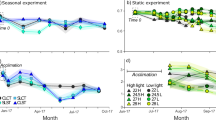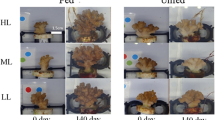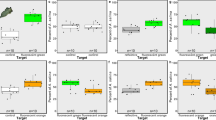Abstract
GROWTH bands on the epithecae of fossil corals, apparently representing yearly and daily growth increments, have recently been used to determine the number of days in the year in the geological past and reveal a possible slowing of the rotation of the Earth1–3. The yearly bands probably result from seasonal temperature variation and the daily bands may well reflect differential growth rate between periods of light and dark as a consequence of the presence of the symbiotic algae Zooxanthellae in the coral tissue4,5. Similar bands have more recently been described in bivalves6–10, but the lack of symbiotic algae in the bivalves makes explanation of the daily bands more difficult than in the corals. To determine whether growth rate in bivalves varies between periods of light and dark, we have conducted a series of radioisotopic tracer experiments.
This is a preview of subscription content, access via your institution
Access options
Subscribe to this journal
Receive 51 print issues and online access
$199.00 per year
only $3.90 per issue
Buy this article
- Purchase on Springer Link
- Instant access to full article PDF
Prices may be subject to local taxes which are calculated during checkout
Similar content being viewed by others
References
Wells, J. W., Nature, 197, 948 (1963).
Scrutton, C. T., Palaeontology, 7, 552 (1964).
Runcorn, S. K., Nature, 204, 823 (1964).
Goreau, T. F., Biol. Bull., 116, 59 (1959).
Goreau, T. F., and Goreau, N. I., Biol. Bull., 117, 239 (1959).
Barker, R. M., Malacologia, 2, 69 (1964).
Pannella, G., and MacClintock, C., J. Paleontol., 42 (5), 64 (1968).
Berry, W. B. N., and Barker, R. M., Nature, 217, 938 (1968).
Clarke, II, G. R., Science, 161, 800 (1968).
House, M. R., and Farrow, G. E., Nature, 219, 1384 (1968).
Malone, P. G., and Dodd, J. R., Limnol. and Oceanog., 12, 432 (1967).
Noll, W., Chemie der Erde. 8, 507 (1934).
Neville, A. C., Biol. Revs., 42, 421 (1967).
Author information
Authors and Affiliations
Rights and permissions
About this article
Cite this article
ROBERT DODD, J. Effect of Light on Rate of Growth of Bivalves. Nature 224, 617–618 (1969). https://doi.org/10.1038/224617a0
Received:
Revised:
Issue Date:
DOI: https://doi.org/10.1038/224617a0
This article is cited by
-
Growth studies of the tropical intertidal limpet Acmaea antillarum
Marine Biology (1977)
Comments
By submitting a comment you agree to abide by our Terms and Community Guidelines. If you find something abusive or that does not comply with our terms or guidelines please flag it as inappropriate.



